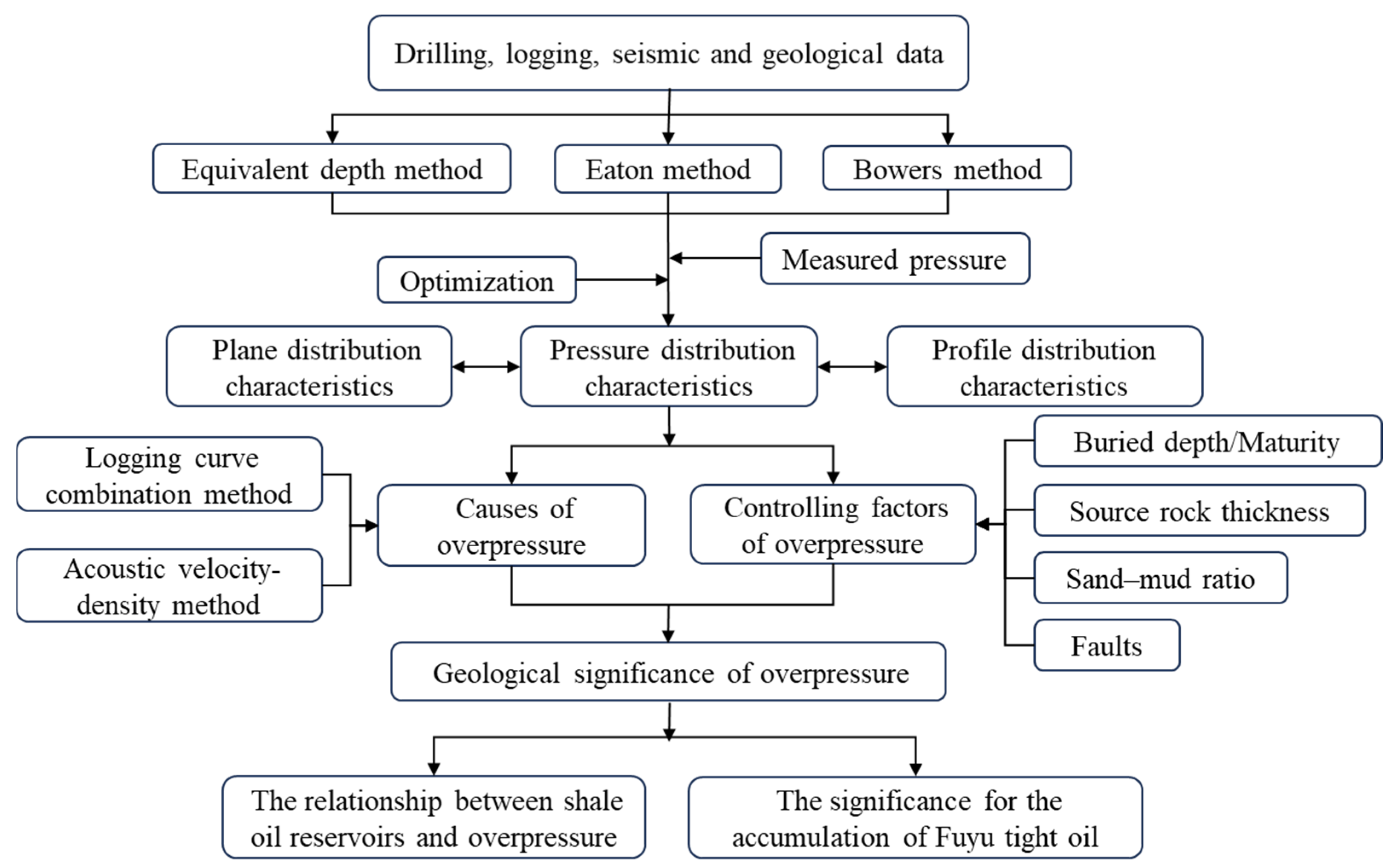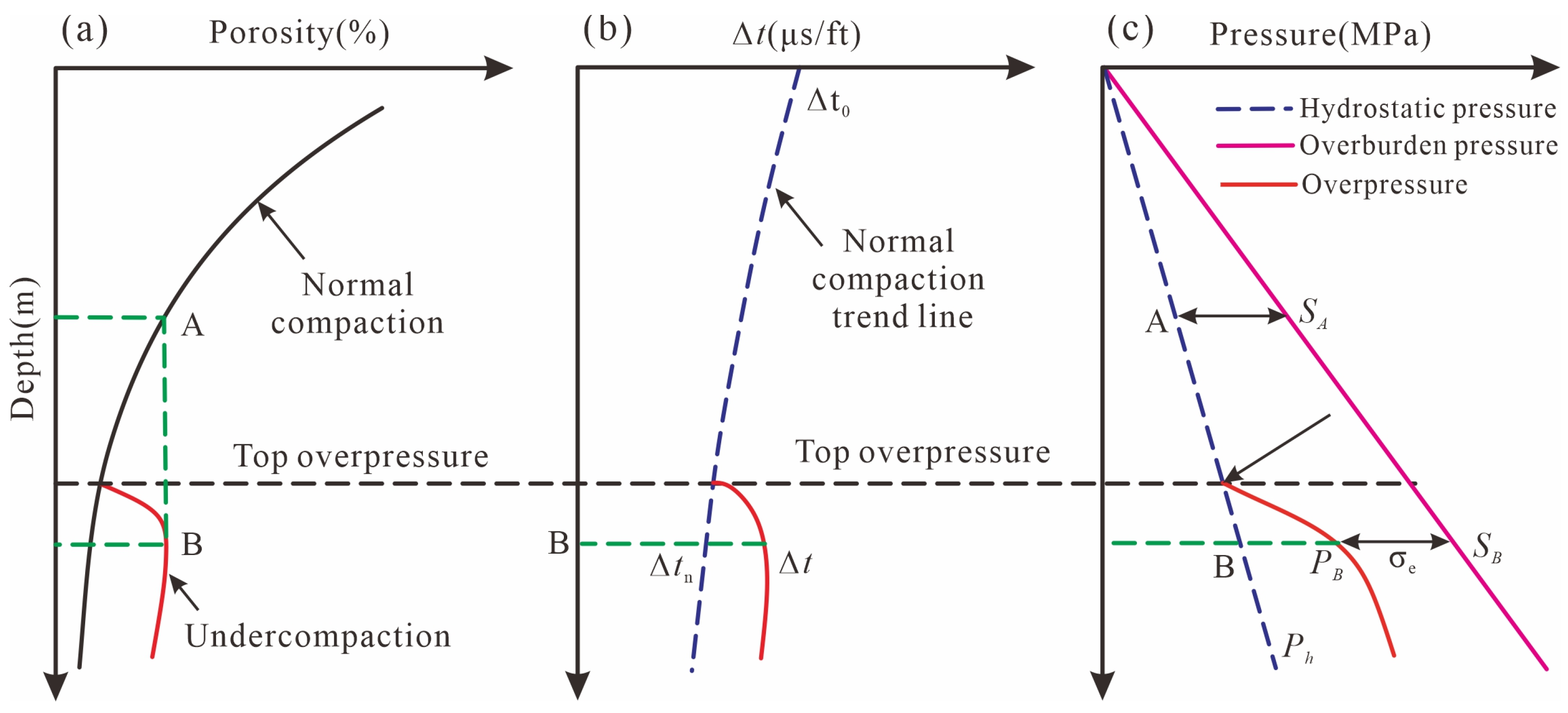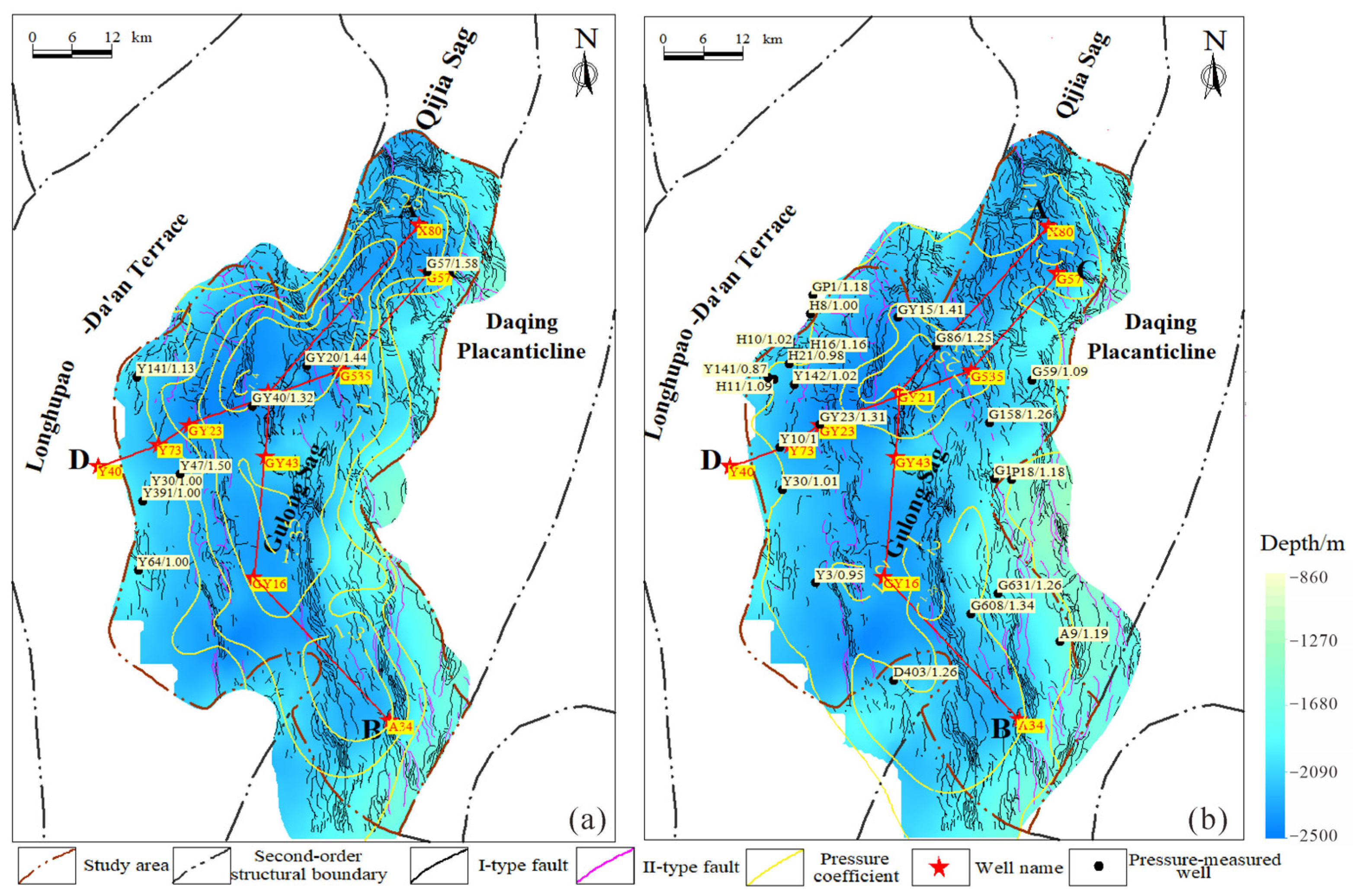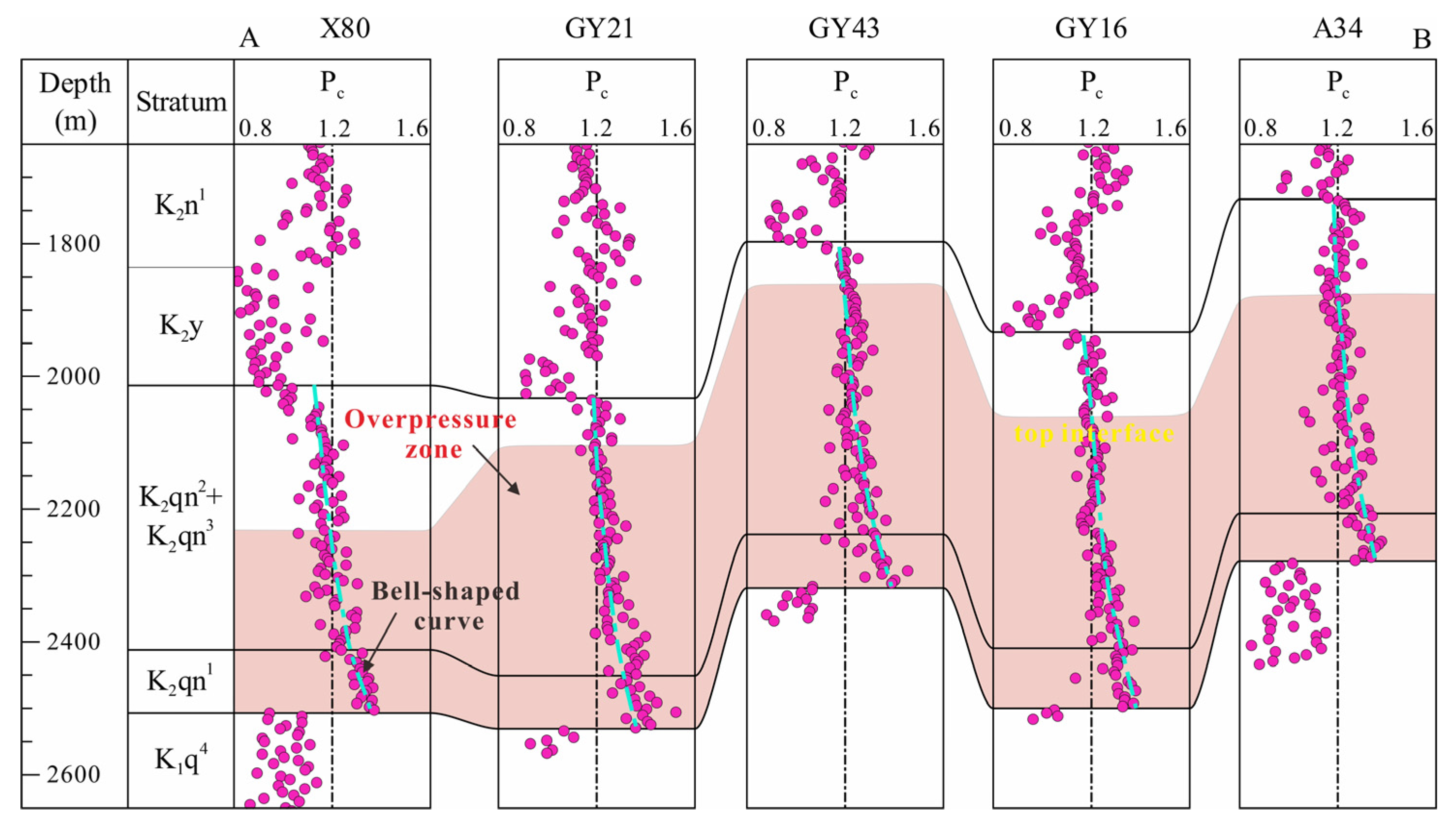Causes and Controlling Factors of Overpressure Systems in the Qingshankou Formation: Insights for Unconventional Oil and Gas Exploration
Abstract
1. Introduction
2. Geological Setting
3. Data and Methodology
3.1. Data
3.2. Methodology
3.2.1. Equivalent Depth Method
3.2.2. Eaton Method
3.2.3. Bowers Method
4. Results and Discussions
4.1. Evaluation of Formation Pore Pressure
4.1.1. Measured Pressure
4.1.2. Optimization of Prediction Methods
4.1.3. Pressure Distribution Characteristics
- (1)
- Plane Distribution Characteristics
- (2)
- Profile Distribution Characteristics
4.2. Causes of Overpressure
4.2.1. Logging Curve Combination Method
4.2.2. Acoustic Velocity–Density Method
4.3. Controlling Factors of Overpressure
4.3.1. Buried Depth/Maturity
4.3.2. Source Rock Thickness
4.3.3. Sand–Mud Ratio
4.3.4. Faults
4.4. Geological Significance of Overpressure
4.4.1. Relationship Between Shale Oil Reservoirs and Overpressure
4.4.2. Significance of the Accumulation of Fuyu Tight Oil
5. Conclusions
- (1)
- The overpressure in the Qingshankou Formation is primarily caused by hydrocarbon generation expansion, with a pressure coefficient that typically exceeds 1.2 and peaks at 1.44, resulting in highly favorable geological conditions for shale oil enrichment.
- (2)
- Regions with greater burial depth, higher maturity, thicker source rocks, and low-er sand-mud ratios have more pronounced overpressure development. Most faults have good sealing properties and can effectively preserve overpressure; only a few open faults lead to local pressure reduction.
- (3)
- In the flank areas with well-developed faults, overpressure in the Qing-1 member can drive reverse hydrocarbon migration into the underlying Fuyu reservoir, facilitating accumulation; in the central sag, where faults are closed, hydrocarbon migration is not obvious, and the “hydrocarbon reversed migration” mechanism and regional caprock characteristics contribute to hydrocarbon preservation.
- (4)
- Future exploration efforts should focus on shale oil in the northwest part of the sag and tight oil within the Fuyu reservoir’s thicker sand bodies on both flanks. Concurrently, systematic research into paleopressure evolution and fault formation is required. By clarifying their spatiotemporal coupling relationships, we can improve our dynamic understanding of hydrocarbon accumulation processes, provide precise theoretical support for exploration target optimization, and, ultimately, increase the success rate of oil and gas exploration.
Author Contributions
Funding
Data Availability Statement
Conflicts of Interest
References
- He, W.; Liu, B.; Zhang, J.; Bai, L.; Tian, S.; Chi, Y. Geological Characteristics and Key Scientific and Technological Problems of Gulong Shale Oil in Songliao Basin. Earth Sci. 2023, 48, 49–62. [Google Scholar] [CrossRef]
- Wang, J.; Chen, F.; Li, W.; Lu, S.; Zhao, S.; Liu, Y.; Wang, Z. A multi-scale and multi-mechanism coupled model for carbon isotope fractionation of methane during shale gas production. Pet. Sci. 2025, 22, 2719–2746. [Google Scholar] [CrossRef]
- Xie, X.; Jiao, J.; Tang, Z.; Zheng, C. Evolution of Abnormally Low Pressure and its Implications for the Hydrocarbon System in the Southeast Uplift Zone of Songliao Basin, China. AAPG Bull. 2003, 87, 99–119. [Google Scholar] [CrossRef]
- Yang, L.; Fu, J.; Chen, C.; Sun, Y.; Gao, R.; Zhou, X.; Liu, C.; Wang, Q. Study on Genetic Mechanism of Overpressure System in Middle-Deep Layers in Western Sag of Liaohe Basin. China Energy Environ. Prot. 2024, 46, 106–108. [Google Scholar] [CrossRef]
- Wang, J.; Lu, S.; Zhang, P.; Li, Q.; Yin, Y.; Li, W.; Zhou, N.; Chen, G.; Yi, Y.; Wu, C. Characterization of shale oil and water micro-occurrence based on a novel method for fluid identification by NMR T2 spectrum. Fuel 2024, 374, 132426. [Google Scholar] [CrossRef]
- Li, X.; Liu, Z.; Ma, X.; Jiao, L.; Zhou, Z.; Xu, X.; Yang, Y. Mechanism of Generation and Prediction of Distribution of Overpressure within the Permian Strata in the Jimusar Depression, Junggar Basin. Acta Geosci. Sin. 2024, 45, 953–964. [Google Scholar] [CrossRef]
- Zhang, H.; Wang, X.; Jia, C.; Li, J.; Meng, Q.; Jiang, L.; Wang, Y. Total Petroleum System and Hydrocarbon Accumulation Model in Shallow and Medium Strata in Northern Songliao Basin, NE China. Pet. Explor. Dev. 2023, 50, 683–694. [Google Scholar] [CrossRef]
- Huang, Y.; Chang, J.; Qiu, N.; Lin, T.; Fu, X.; Tang, B.; Li, J. Pressure Field Characteristics and Overpressure Geneses of Qingshankou Formation in Qijia-Gulong Sag, Songliao Basin. Acta Pet. Sin. 2024, 45, 1800–1817. [Google Scholar] [CrossRef]
- Fu, G.; Sun, K.; Song, G. Difference of Formation and Evolution of Overpressure of K1qn1 Mudstone East and West of Daqing Placanticline. J. Northeast. Pet. Univ. 2008, 32, 1–4+121. [Google Scholar] [CrossRef]
- Jiang, L.; Zhang, X.; Ma, X. K1qn1 Mudstone Overpressure in North Songliao Basin and its Significance. Pet. Geol. Oilfield Dev. Daqing 2013, 32, 25–28. [Google Scholar] [CrossRef]
- Ren, L.; Dai, J.; Lin, C.; Cao, Z. Characteristics of Overpressure and its Geological Significance for Hydrocarbon of Qingshankou Formation in Southern Fuxin Uplift, Songliao Basin. Nat. Gas Geosci. 2017, 28, 1020–1030. [Google Scholar] [CrossRef]
- Lei, Z.; Xie, X.; Huang, W.; Du, X.; Wang, W.; Wang, W.; Jiao, J.; Wei, W. Abnormal Pressure System Characteristics of Mid-Shallow Formation in Qijiagulong-Sanzhao Depression of Songliao Basin, China. J. Jilin Univ. (Earth Sci. Ed.) 2012, 42 (Suppl. S1), 96–104. [Google Scholar] [CrossRef]
- Zhu, G.; Wang, X.; Bai, X.; Lu, J.; Li, J. New Exploration Fields and Resource Potential of Tight Oil in Northern Songliao Basin. Acta Pet. Sin. 2025, 46, 33–47. [Google Scholar] [CrossRef]
- Qu, J. Enrichment Regularity and Main Controlling Factors of the Tight Oil in Fuyu Oil-Bearing in Longxi Area, Songliao Basin. J. Yangtze Univ. (Nat. Sci. Ed.) 2025, 1–14. [Google Scholar] [CrossRef]
- He, W.; Zhao, Y.; Zhong, J.; Sun, N. Characteristics and Significance of Micron Pores and Micron Fractures in Shale Oil Reservoirs of Cretaceous Qingshankou Formation in Gulong Sag, Songliao Basin. Lithol. Reserv. 2024, 36, 1–18. [Google Scholar] [CrossRef]
- Cao, Z.; Lin, J.; Ling, L.; Wang, X.; Tan, X.; Wang, H.; Zhao, H.; Xu, R.; Zhang, Y. The Cause of Shale Oil Overpressure and its Influence on Productivity in Jimsar Sag. Well Logging Technol. 2025, 49, 298–309+328. [Google Scholar] [CrossRef]
- Hottmann, C.; Johnson, R. Estimation of Formation Pressures from Log-Derived Shale Properties. J. Pet. Technol. 1965, 17, 717–722. [Google Scholar] [CrossRef]
- Eberhart-Phillips, D.; Han, D.; Zoback, M. Empirical Relationships among Seismic Velocity, Effective Pressure, Porosity, and Clay Content in Sandstone. Geophysics 1989, 54, 82–89. [Google Scholar] [CrossRef]
- Bowers, G. Pore Pressure Estimation From Velocity Data: Accounting for Overpressure Mechanisms Besides Undercompaction. SPE Drill. Complet. 1995, 10, 89–95. [Google Scholar] [CrossRef]
- Dutta, N. Geopressure Prediction Using Seismic Data: Current Status and the Road ahead. Geophysics 2002, 67, 2012–2041. [Google Scholar] [CrossRef]
- Sargent, C.; Goulty, N.; Cicchino, A.; Ramdhan, A. Budge-Fudge Method of Pore-Pressure Estimation from Wireline Logs with Application to Cretaceous Mudstones at Haltenbanken. Pet. Geosci. 2015, 21, 219–232. [Google Scholar] [CrossRef]
- Eaton, B. The Equation for Geopressure Prediction from Well Logs. In Proceedings of the Fall Meeting of the Society of Petroleum Engineers of AIME, Dallas, TX, USA, 28 September–1 October 1975. [Google Scholar] [CrossRef]
- Fillippone, W. Estimation of Formation Parameters and the Prediction of Overpressures from Seismic Data. In SEG Technical Program Expanded Abstracts 1982; Society of Exploration Geophysicists: Houston, TX, USA, 1982; pp. 502–503. [Google Scholar] [CrossRef]
- Martinez, R. Deterministic Estimation of Porosity and Formation Pressure from Seismic Data. In SEG Technical Program Expanded Abstracts 1985; Society of Exploration Geophysicists: Houston, TX, USA, 1985; pp. 486–487. [Google Scholar] [CrossRef]
- Liu, Z.; Zhang, W.; Zhang, H.; Deng, Y. An Analysis of Abnormal Formation Pressures of Paleogene in the North Sag of Liaoxi Depression. Acta Pet. Sin. 1993, 14, 14–24. [Google Scholar] [CrossRef]
- Farsi, M.; Mohanmadian, N.; Ghorbani, H.; Wood, D.; Alvar, M. Predicting Formation Pore-Pressure from Well-Log Data with Hybrid Machine-Learning Optimization Algorithms. Nat. Resour. Res. 2021, 30, 3455–3481. [Google Scholar] [CrossRef]
- Georgy, P.; Kerim, K.; Sergey, S.; Nikita, B.; Ammar, A.; Mahmoud, A. Predicting Mud Weight in Carbonate Formations Using Seismic Data: A Data-Driven Approach. Geoenergy Sci. Eng. 2025, 250, 213850. [Google Scholar] [CrossRef]
- Li, K.; Chen, S.; Zhao, H.; Wang, T.; Huo, Q. Predicting Method of the Pore Pressure in Qingshankou-Formation Mud Shale of Songliao Basin and its Application. Pet. Geol. Oilfield Dev. Daqing 2018, 37, 7–12. [Google Scholar] [CrossRef]
- Shi, M.; Liu, Z.; Yang, X.; Yang, J.; Chen, X.; Liu, H.; Cao, J. Review and Prospect Prediction Technology for Formation Pore Pressure by Geophysical Well Logging. Prog. Geophys. 2020, 35, 1845–1853. [Google Scholar] [CrossRef]
- Zhao, J.; Li, J.; Xu, Z. Advances in the Origin of Overpressures in Sedimentary Basins. Acta Pet. Sin. 2017, 38, 973–998. [Google Scholar] [CrossRef]
- Du, H.; Liu, Y.; Fan, L.; Ma, Z.; Luo, X.; Shen, A.; Zeng, S. Genesis and Evolution of Overpressure in Lower Paleozoic Carbonate Rocks of Ordos Basin. Acta Pet. Sin. 2025, 46, 891–908. [Google Scholar] [CrossRef]
- Xu, Z.; Zhao, J.; Li, J. The Impact of Organic Matter Content on Overpressure Analysis and Its Correction Method in the First Member of Cretaceous Qingshankou Formation, Placanticline Area, Songliao Basin. Oil Gas Geol. 2019, 40, 938–946. [Google Scholar] [CrossRef]
- Zhang, Z.; Chang, J.; Shan, X.; Li, C.; Guo, H.; Peng, B.; Xu, J.; Huang, Y. Pressure Distribution Characteristics and Overpressure Genesis of the Permian Formation in Mahu Sag and Surrounding Areas. Chin. J. Geol. 2024, 59, 1229–1244. [Google Scholar] [CrossRef]
- Wang, Y.; Hao, X.; An, T.; Zhang, P.; Xiong, W.; Qin, F. Co-evolution of Formation Pressure, Fluid, and Reservoir Property under the Control of Basin Structure and its Controlling Effect on Reservoir Accumulation: A Case Study of Paleogene in Dongying Depression. Acta Pet. Sin. 2023, 4, 1058–1071. [Google Scholar] [CrossRef]
- Qiu, Y. Overpressure Structure in Dongying Sag and its Controlling Factors. China Pet. Explor. 2018, 23, 28–34. [Google Scholar] [CrossRef]
- Dang, X.; He, S.; Wang, Y.; Hao, X.; Zhang, J. Distribution Characteristics and Controlling Factors of the Overpressure Zone in Sandstone Reservoir of Gubei Sag. Pet. Geol. Recovery Effic. 2016, 23, 47–52. [Google Scholar] [CrossRef]
- Bao, Y.; Zhang, L.; Li, J. Approach to Paleogene Overpressure Origin in Jiyang Depression. Xinjiang Pet. Geol. 2012, 33, 17–21. [Google Scholar]
- Liu, H.; Yuan, F.; Jiang, Y.; Hao, X.; Fang, X. Genesis and Characteristics of Paleogene Overpressure in Zhanhua Depression, Jiyang Sub-basin. J. China Univ. Pet. (Ed. Nat. Sci.) 2021, 45, 23–32. [Google Scholar] [CrossRef]
- Chen, H.; Zhang, F.; Jiang, Q.; Liu, H.; Sun, L.; Liu, G. Overpressure-Generating Mechanism and Its Evolution Characteristics of Cretaceous Shahezi Formation in Xujiaweizi Fault Depression, Songliao Basin. Lithol. Reserv. 2025, 37, 102–114. [Google Scholar] [CrossRef]
- Liu, B.; Meng, Q.; Fu, X.; Lin, T.; Bai, Y.; Tian, S.; Zhang, J.; Yao, Y.; Cheng, X.; Liu, Z. Composition of generated and expelled hydrocarbons and phase evolution of shale oil in the 1st member of Qingshankou Formation, Songliao Basin. Oil Gas Geol. 2024, 45, 406–419. [Google Scholar] [CrossRef]
- Li, C.; Luo, X.; Zhang, L.; Fan, C.; Xu, C.; Liu, A.; Li, H.; Li, J.; Lei, Y. New Understanding of Overpressure Responses and Pore Pressure Prediction: Insights from the Effect of Clay Mineral Transformations on Mudstone Compaction. Eng. Geol. 2022, 297, 106493. [Google Scholar] [CrossRef]
- Liu, B.; Shi, J.; Fu, X.; LU, Y.; Sun, X.; Gong, L.; Bai, Y. Petrological Characteristics and Shale Oil Enrichment of Lacustrine Fine-grained Sedimentary System: A Case Study of Organic-rich Shale in First Member of Cretaceous Qingshankou Formation in Gulong Sag, Songliao Basin, NE China. Pet. Explor. Dev. 2018, 45, 828–838. [Google Scholar] [CrossRef]
- Chen, F.; Lu, S.; Huang, Z.; Wang, W.; Xie, Z.; Xiao, H. Sedimentary Characteristics and Favorable Exploration Zone of K1qn1 in Gulong Depression of Songliao Basin. J. Cent. South Univ. (Sci. Technol.) 2013, 44, 1955–1963. [Google Scholar]
- Sun, L.; Zhu, R.; Zhang, T.; Cai, Y.; Feng, Z.; Bai, B.; Jiang, H.; Wang, B. Advances and Trends of Non-Marine Shale Sedimentology: A Case Study from Gulong Shale of Daqing Oilfield, Songliao Basin, NE China. Pet. Explor. Dev. 2024, 51, 1367–1385. [Google Scholar] [CrossRef]
- Lin, T.; Wang, R.; Zhang, J.; Liu, Z.; Bai, Y.; Cheng, X.; Liu, X.; Lu, J.; Ma, S.; Li, X. Enrichment Law and Favorable Areas Distribution of Gulong Shale Oil in Songliao Basin. Pet. Geol. Oilfield Dev. Daqing 2024, 43, 88–98. [Google Scholar] [CrossRef]
- Zhu, G.; Wang, X.; Zhang, J.; Liu, Z.; Bai, Y.; Zhao, Y.; Fu, X.; Zeng, H. Enrichment Conditions and Favorable Zones for Exploration and Development of Continental Shale Oil in Songliao Basin. Acta Pet. Sin. 2023, 44, 110–124. [Google Scholar] [CrossRef]
- Fu, X.; Chang, J.; Tang, B.; Zhu, C.; Li, X.; Huang, Y.; Su, Y.; Xu, Q.; Meng, Q. Rapid Maturation Evolution of the Shale Oil in the Heat Sedimentary Basins: A Casestudy of the Qijiagulong Sag in Songliao Basin, Northeastern China. Chin. J. Geophys. 2025, 68, 182–198. [Google Scholar] [CrossRef]
- Yang, X.; Liu, C.; Wang, F.; Li, G.; Feng, D.; Yang, T.; He, Z.; Su, J. Distribution and Origin of Overpressure in the Paleogene Dongying Formation in the Southwestern Sub-sag, Bozhong Sag, Bohai Bay Basin. Oil Gas Geol. 2024, 45, 96–112. [Google Scholar] [CrossRef]
- Zhang, J. Pore pressure prediction from well logs: Methods, modifications, and new approaches. Earth-Sci. Rev. 2011, 108, 50–63. [Google Scholar] [CrossRef]
- Zhao, Q.; Wang, X.; Guan, L.; Zhang, W.; Zhu, J. Formation Pressure Detection Method Based on Modified Bowers Method-Taking Baiyun Sag as an Example. Theory Pract. New Ind. 2022, 9, 123–130. [Google Scholar] [CrossRef]
- Lou, Z.; Gao, R.; Cai, X.; Xu, H. The Evolution of Fluid Dynamic Field and the Origin of Subnormal Pressure in Songliao Basin, China. Acta Pet. Sin. 1999, 20, 21–31. [Google Scholar] [CrossRef]
- Li, W.; Chen, Z.; Huang, P.; Yu, Z.; Min, L.; Lu, X. Formation of overpressure system and its relationship with the distribution of large gas fields in typical foreland basins in central and western China. Pet. Explor. Dev. 2021, 48, 536–548. [Google Scholar] [CrossRef]
- Shen, J.; Cong, Y.; Mao, L.; Lu, S. Mechanism of Putaohua Oil Layer’s Overpressure in the Gulong Sag, Songliao Basin. Chin. J. Geol. 2009, 44, 502–512. [Google Scholar] [CrossRef]
- Liu, T.; Liu, J. Quantitative Evaluation on Overpressure Generated from Undercompaction and Fluid Expansion. Acta Pet. Sin. 2018, 39, 971–979. [Google Scholar] [CrossRef]
- Han, Y. The Relationship Between Sandstone Diagenesis and Overpressure Fuild of the Shahejie Formation in Dongying Depression. Master’s Thesis, China University of Geosciences, Beijing, China, 2012. Available online: https://d.wanfangdata.com.cn/thesis/Y2189335 (accessed on 25 August 2025).
- Bai, G.; Chen, G.; Cai, Z.; Yan, H.; Lu, S.; Radwan, A. Movable oil content evaluation in low-to-medium maturity lacustrine shale during in-situ conversion. Adv. Geo-Energy Res. 2025, 16, 77–90. [Google Scholar] [CrossRef]
- Ma, W.; Li, J.; Wang, D.; Wang, Y.; Ma, C.; Wang, Z.; Du, T. Hydrocarbon expulsion efficiency of source rocks and its influencing factors. Nat. Gas Geosci. 2016, 27, 1742–1751. [Google Scholar] [CrossRef]
- Zhao, G. Study of the Abnormal High-Pressure in Hydrocarbon Source Rocks—Taking Paleogene in the Dongying Sag, the Bohai Bay Basin as an Example. Pet. Geol. Exp. 2008, 4, 340–344. [Google Scholar] [CrossRef]
- Li, W.; Wang, J.; Jia, C.; Lu, S.; Li, J.; Zhang, P.; Wei, Y.; Song, Z.; Chen, G.; Zhou, N. Carbon isotope fractionation during methane transport through tight sedimentary rocks: Phenomena, mechanisms, characterization, and implications. Geosci. Front. 2024, 15, 101912. [Google Scholar] [CrossRef]
- Jin, Q.; Gan, J.; Lu, M.; He, S.; Sun, S.; Wang, J.; Gao, Y. Analysis of the Causes of Formation Overpressures in the Chezhen Sag of Bohai Bay Basin. J. Northeast. Pet. Univ. 2015, 39, 32–40+6–7. [Google Scholar] [CrossRef]
- Jing, C.; Liu, H.; Jing, X.; Feng, Y.; Zhao, M. Prediction of Overpressures Generated by Fluid Expansion: Methods and Application. Xinjiang Pet. Geol. 2016, 37, 240–245. [Google Scholar] [CrossRef]
- Wang, X.; Bai, X.; Li, J.; Jin, Z.; Wang, G.; Chen, F.; Zheng, Q.; Hou, Y.; Yang, Q.; Li, J.; et al. Enrichment Model and Major Controlling Factors of Below-source Tight Oil in Lower Cretaceous Fuyu Reservoirs in Northern Songliao Basin, NE China. Pet. Explor. Dev. Online 2024, 51, 279–291. [Google Scholar] [CrossRef]
- Wang, Y.; Chen, B.; Chen, J. Roof and Floor Faults Seal of Gulong Shale Oil Reservoir in Songliao Basin and Optimization of Favorable Areas for Oil and Gas Accumulation. Pet. Geol. Oilfield Dev. Daqing 2022, 41, 53–67. [Google Scholar] [CrossRef]
- Li, Y.; Chen, G.; Cai, Z.; Lu, S.; Wang, F.; Zhang, Y.; Bai, G.; Ge, J. Occurrence of methane in organic pores with surrounding free water: A molecular simulation study. Chem. Eng. J. 2024, 497, 155597. [Google Scholar] [CrossRef]
- Liang, Z.; Wang, J.; Yu, T. Coexisting relationship between shale gas enrichment and over-pressure system in east China. Prog. Geophys. 2017, 32, 1591–1596. [Google Scholar] [CrossRef]
- Jia, C.; Yao, J.; Kamy, S. Acid Stimulation Simulation Theory and Application in Carbonate Rocks; Springer: Berlin/Heidelberg, Germany, 2025; pp. 1–274. [Google Scholar] [CrossRef]













Disclaimer/Publisher’s Note: The statements, opinions and data contained in all publications are solely those of the individual author(s) and contributor(s) and not of MDPI and/or the editor(s). MDPI and/or the editor(s) disclaim responsibility for any injury to people or property resulting from any ideas, methods, instructions or products referred to in the content. |
© 2025 by the authors. Licensee MDPI, Basel, Switzerland. This article is an open access article distributed under the terms and conditions of the Creative Commons Attribution (CC BY) license (https://creativecommons.org/licenses/by/4.0/).
Share and Cite
Chen, F.; Fu, X.; Zheng, Q.; Lu, S.; Li, J.; Li, M.; Bai, G.; Wang, S. Causes and Controlling Factors of Overpressure Systems in the Qingshankou Formation: Insights for Unconventional Oil and Gas Exploration. Processes 2025, 13, 2790. https://doi.org/10.3390/pr13092790
Chen F, Fu X, Zheng Q, Lu S, Li J, Li M, Bai G, Wang S. Causes and Controlling Factors of Overpressure Systems in the Qingshankou Formation: Insights for Unconventional Oil and Gas Exploration. Processes. 2025; 13(9):2790. https://doi.org/10.3390/pr13092790
Chicago/Turabian StyleChen, Fangju, Xiuli Fu, Qiang Zheng, Shuangfang Lu, Jie Li, Mengxia Li, Guoshuai Bai, and Suo Wang. 2025. "Causes and Controlling Factors of Overpressure Systems in the Qingshankou Formation: Insights for Unconventional Oil and Gas Exploration" Processes 13, no. 9: 2790. https://doi.org/10.3390/pr13092790
APA StyleChen, F., Fu, X., Zheng, Q., Lu, S., Li, J., Li, M., Bai, G., & Wang, S. (2025). Causes and Controlling Factors of Overpressure Systems in the Qingshankou Formation: Insights for Unconventional Oil and Gas Exploration. Processes, 13(9), 2790. https://doi.org/10.3390/pr13092790





